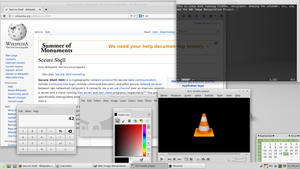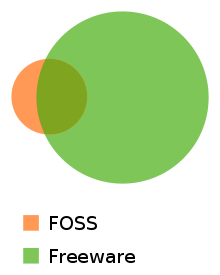Free software
Free software (or libre software)[1][2] is computer software distributed under terms that allow users to run the software for any purpose as well as to study, change, and distribute it and any adapted versions.[3][4][5][6] Free software is a matter of liberty, not price; all users are legally free to do what they want with their copies of a free software (including profiting from them) regardless of how much is paid to obtain the program.[7][2] Computer programs are deemed "free" if they give end-users (not just the developer) ultimate control over the software and, subsequently, over their devices.[5][8]
The right to study and modify a computer program entails that source code—the preferred format for making changes—be made available to users of that program. While this is often called "access to source code" or "public availability", the Free Software Foundation (FSF) recommends against thinking in those terms,[9] because it might give the impression that users have an obligation (as opposed to a right) to give non-users a copy of the program.
Although the term "free software" had already been used loosely in the past,[10] Richard Stallman is credited with tying it to the sense under discussion and starting the free-software movement in 1983, when he launched the GNU Project: a collaborative effort to create a freedom-respecting operating system, and to revive the spirit of cooperation once prevalent among hackers during the early days of computing.[11][12]
For software under the purview of copyright to be free, it must carry a software license whereby the author grants users the aforementioned rights. Software that is not covered by copyright law, such as software in the public domain, is free as long as the source code is in the public domain too, or otherwise available without restrictions.
Proprietary software uses restrictive software licences or EULAs and usually does not provide users with the source code. Users are thus legally or technically prevented from changing the software, and this results in reliance on the publisher to provide updates, help, and support. (See also vendor lock-in and abandonware). Users often may not reverse engineer, modify, or redistribute proprietary software.[14][15] Beyond copyright law, contracts and lack of source code, there can exist additional obstacles keeping users from exercising freedom over a piece of software, such as software patents and digital rights management (more specifically, tivoization).[16]
Free software can be a for-profit, commercial activity or not. Some free software is developed by volunteer computer programmers while other is developed by corporations; or even by both.[17][7]

